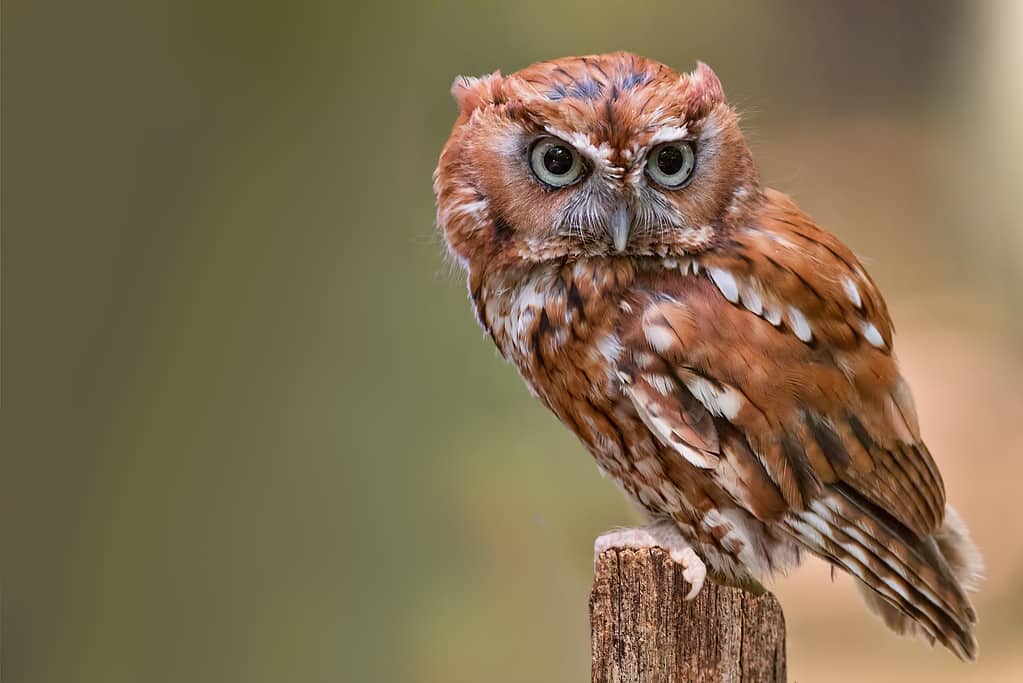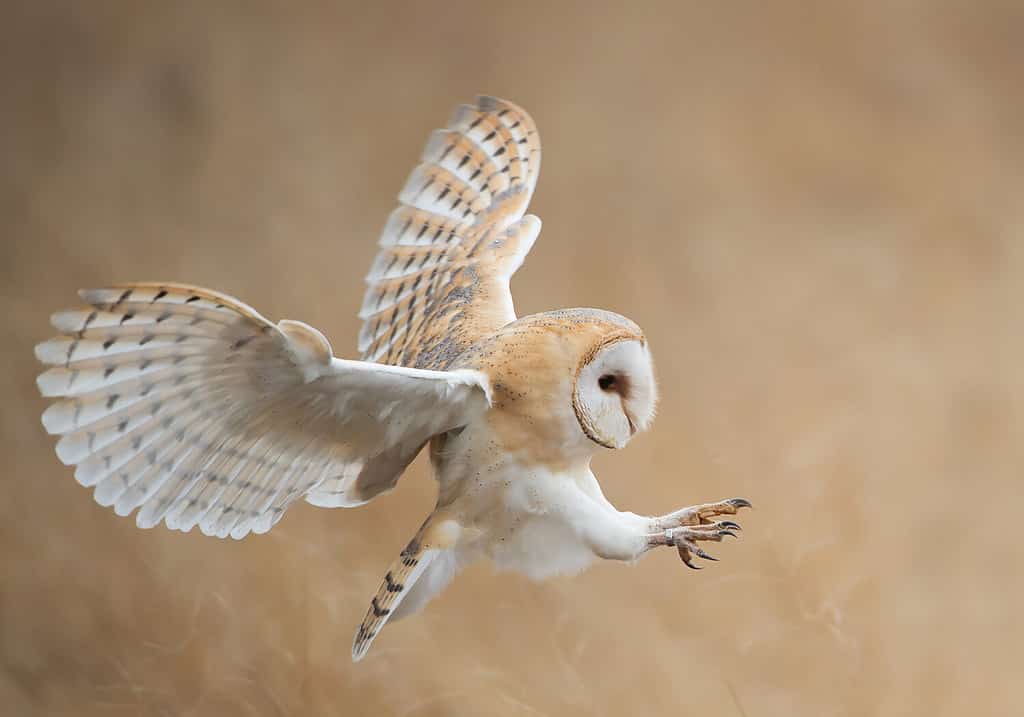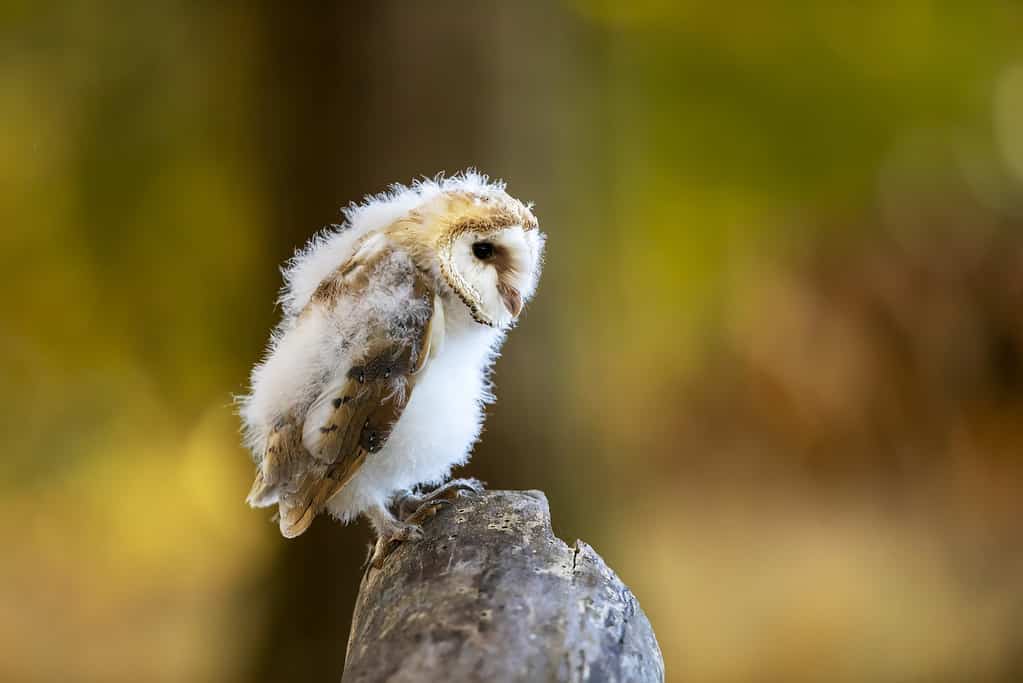Owls are some of the most famous birds of prey around. Since they live throughout the world, they have cultural significance in many areas. Going back thousands of years, owls have held certain meanings and omens, plus had rules surrounding them, even in the Bible. Today, we will look at owls in the Bible to learn what they meant and why they appeared in the text! Let’s discover the meaning of owls and their symbolism in the Bible!
Where Are Owls Mentioned in the Bible?

The screech owl is directly mentioned in a few places in the Bible.
©Jens_Lambert_Photography/iStock via Getty Images
Owls exclusively appear in the Old Testament of the Bible. Let’s go through the Bible’s mentions of owls and see the context.
Leviticus 11:16-18 and Deuteronomy 14:15-17
16 the horned owl, the screech owl, the gull, any kind of hawk, 17 the little owl, the cormorant, the great owl, 18 the white owl, the desert owl, the osprey,
NIV
These passages list the birds considered unclean and forbidden to eat by the Israelites. The passages appear in a section of scripture known as the Pentateuch. The list of barred birds includes the owl, the little owl, the great owl, and the white owl. It also details which species should not be consumed. Leviticus and Deuteronomy are part of the Torah. The Torah is the first five books of the Bible that contain the laws and history of Israel. Most scholars recognize that the completion of the final form of the Torah as between 539 and 333 BCE; however, some claim it’s a touch earlier, as recent as 164 BCE.
Psalm 102:6
6 I am like a desert owl, like an owl among the ruins.
NIV
This verse describes the psalmist’s (the psalm writer) loneliness and misery. He compares himself to a pelican of the wilderness (the previous verse) and an owl of the waste places. The Psalms are a collection of 150 songs and prayers that convey the vast array of human emotions expressed to God. They were written by different authors over a span of several centuries, from around 1000 BC to 400 BC.
Isaiah 13:21; 34:11,14; 38:14
- 13:21 But desert creatures will lie there,
jackals will fill her houses;
there the owls will dwell,
and there the wild goats will leap about. - 34:11 The desert owl and screech owl will possess it;
the great owl and the raven will nest there.
God will stretch out over Edom
the measuring line of chaos
and the plumb line of desolation. - Verses 34:14 and 38:14 don’t contain direct references to owls in the NIV, although certain translations may. (i.e., “creatures of the night”)
There are a few verses that use owls as symbols of desolation, ruin, and judgment across Isaiah. They depict owls dwelling in places once inhabited by people or animals but are now deserted and cursed by God. We’re seeing a trend here, as being alone or isolated is often accompanied by visual images of an owl! Isaiah is a prophetic book that details God’s messages to Israel and other nations through a “prophet” or speaker on behalf of God. It was likely written around 700 BC (although some textual critics have a theory involving split writings that date as recent as the end of the Babylonian exile) and came during a period when there was incredible upheaval in the nation of Israel.
Jeremiah 50:39
So desert creatures and hyenas will live there,
NIV
and there the owl will dwell.
It will never again be inhabited
or lived in from generation to generation.
Again, this verse is similar to Isaiah’s prophecies in its reference to something as barren, lonely, and deserted. This section is foretelling the destruction of Babylon by God’s wrath, bringing in the owl to explain just how deserted the cities will be. It says that desert creatures, jackals, and owls will live in Babylon after its fall. Jeremiah is another prophetic book that records God’s warnings and promises to Israel through his prophet Jeremiah. It was written around 600 BC, when Babylon invaded and exiled Judah, the southern kingdom of Israel.
Micah 1:8
8 Because of this I will weep and wail;
NIV
I will go about barefoot and naked.
I will howl like a jackal
and moan like an owl.
For a little context, this verse shows Micah’s grief and lamentation (a biblical word for immense sadness) over the sins and judgments of Israel and Judah (the two kingdoms that made up greater Israel). He says that he will wail like jackals and mourn like owls, once again using these desert animals to reference sadness and loss at the desertion/destruction of cities of importance. Also, the sound of an owl at night has a sad call, and Micah is saying that’s how he will sound as he laments. Micah is a minor prophetic book that contains God’s messages to his people, similar to Isaiah and Jeremiah. It was written around 700 BC, during the same period as Isaiah.
Zephaniah 2:14
14 Flocks and herds will lie down there,
NIV
creatures of every kind.
The desert owl and the screech owl
will roost on her columns.
Their hooting will echo through the windows,
rubble will fill the doorways,
the beams of cedar will be exposed.
This verse is also similar to Isaiah’s prophecies, as it predicts the desolation of Nineveh, the capital of Assyria, by God’s judgment. It says that flocks of birds, including owls, will nest in its ruins. For the final mention of owls in the Bible, we see that, once again, this is a reference to desolation and the destruction of a city left to abandonment. Zephaniah is a minor prophetic book that contains God’s messages to Judah and other nations through his prophet Zephaniah. It was written around 620 BC, before the fall of Nineveh in 612 BC.
What Do Owls Symbolize in the Bible?

Owls are often mentioned as a way to symbolize desolation, loneliness, or abandonment.
©MZPHOTO.CZ/Shutterstock.com
There are two main ways that we see owls show up in the bible: once as a dietary reference and a few times as a way to express grief, loneliness, or desolation.
First mentioned, they are among the birds that are considered “unclean” and forbidden to eat by the Israelites. This means that owls were regarded as impure, detestable, and abominable animals that could defile the people and make them unfit for worshiping God. The reason why owls and other birds were classified as unclean is not explicitly stated in the Bible. However, some scholars believe it may have to do with their diet, behavior, or association with pagan cultures. Many things associated with pagan cultures were outright rejected by the Israelites.
Second, owls are used as symbols of desolation, ruin, and judgment in the prophetic books of the Bible. They are said to live in places once inhabited by people but that are now deserted and cursed by God because of sin. Owls represent the emptiness, darkness, and loneliness that result from God’s wrath and abandonment. They also signify the futility and hopelessness of those who oppose God and his people. You don’t want a prophet to reference an owl when they talk about your city if you live in Biblical times!
Why Are There No Owls in the New Testament?

When it comes to owls in the Bible, there are no verses about the birds from the New Testament.
©scigelova/iStock via Getty Images
Looking at the list, it’s easy to notice a trend: none of our verses are from the New Testament! Why is that? Well, it has to do with the different focus and genres of the two parts of the Bible.
The Old Testament is mostly about the history and laws of Israel and the prophecies of God’s judgment on them and other nations. The New Testament is mostly about the life and teachings of Jesus and the creation and attempted direction of the budding church.
Essentially, the New Testament doesn’t have as much prophetic or legal literature as the Old Testament, which is where owls usually appear. The only book in the New Testament that might have had owls is Revelation, mostly because it uses a lot of images and symbols to describe the future. Still, they aren’t mentioned, but other animals are, including horses, lions, eagles, locusts, scorpions, frogs, and dragons.
Thank you for reading! Have some feedback for us? Contact the AZ Animals editorial team.








